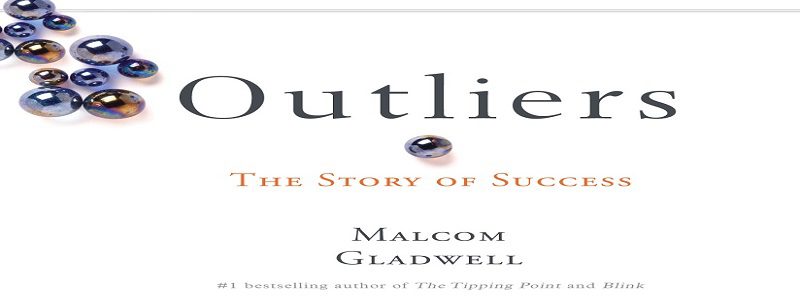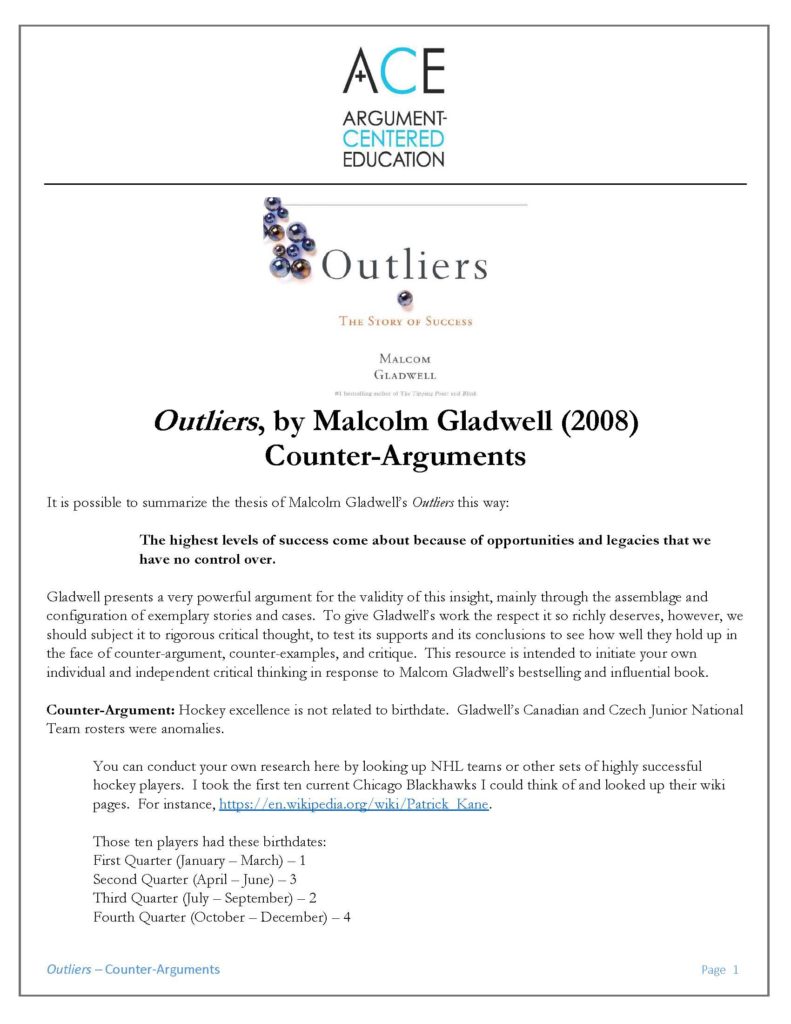
Thinking Critically about ‘Outliers’
What does “critical thinking” mean? What does it mean to think critically? Kenneth Burke, in his A Grammar of Motives, had a name for words or phrases with the cachet and power that the term “critical thinking.” He called them “god terms” — “names for the ultimate of motivation.” No god term in education is defined as variously, or is as elusive, as “critical thinking.” But one of the most influential definitions remains one of the original ones. Education theorist Edward M. Glaser was building on the work of American philosopher John Dewey when he wrote in An Experiment in the Development of Critical Thinking (Columbia University Press, 1941):
The ability to think critically, as conceived in this volume, involves three things: ( 1 ) an attitude of being disposed to consider in a thoughtful way the problems and subjects that come within the range of one’s experiences, (2) knowledge of the methods of logical inquiry and reasoning, and (3) some skill in applying those methods. Critical thinking calls for a persistent effort to examine any belief or supposed form of knowledge in the light of the evidence that supports it and the further conclusions to which it tends. It also generally requires ability to recognize problems, to find workable means for meeting those problems, to gather and marshal pertinent information, to recognize unstated assumptions and values, to comprehend and use language with accuracy, clarity, and discrimination, to interpret data, to appraise evidence and evaluate arguments, to recognize the existence (or non-existence) of logical relationships between propositions, to draw warranted conclusions and generalizations, to put to test the conclusions and generalizations at which one arrives, to reconstruct one’s patterns of beliefs on the basis of wider experience, and to render accurate judgments about specific things and qualities in everyday life.
There is a lot packed in to this definition, and rightly so. But we like to distill, to concentrate, functions like “appraising evidence,” “evaluating arguments,” “recognizing the existence (or non-existence” of logical relationships,” “putting to the test conclusions and generalizations,” and “rendering accurate judgements.” We look to the Greek root of “critical” — kritikos, a critic, one who makes judgments — and we condense critical thinking to the process of judging the validity, meaning, truth, or quality of the object of study. And when reading or listening in an academic context, that very often means subjecting the text or speech act to the skeptical, evaluative thinking — what is it communicating and why should I believe it? what is the argument and what is its basis? what is the author saying and why might they be wrong (or, if the text holds up, what are they likely to be right)?
We want our students thinking critically as much as possible, throughout the curriculum, and as a habit of mind. It is through the routine practice of critical thinking that students become adept, their faculties honed, their cognitive muscles and neural, synaptical functions fully developed. In this way, critical thinking is like other mental and physical capacities. One way to think of argument-centered instruction is that it is a pedagogy that strives to find and act on all of the opportunities available, inherent, or latent within curriculum to think critically, and to work with teachers to design or adapt implementation tools to take full advantage of these opportunities.
In academic argument, it is in the production of counter-arguments, and then the response to or refutation of counter-arguments, that critical thinking is most acutely activated. In fact, it is because of the need to think so carefully about and to make evaluations of what others are saying — first, to judge whether you agree with it or not, and then to defend your position in relation to other positions — that academic argument is often recognized as a pedagogical engine of critical thought.
A recent collaboration that we undertook with a partner high school illustrates the way that argument-centered instruction elevates the counter-argument to a very prominent place in order to activate students’ critical thinking. This school’s AP Language and Composition teacher conducts a four-week unit on Malcolm Gladwell’s, Outliers: The Story of Success (Little, Brown & Co., 2008). This is Canadian journalist Gladwell’s third work, and it widely praised and generally considered a compelling and influential work of popular social science. It is the book with the “10,000 hour rule” — that it takes 10,000 hours of focused practice to achieve mastery of any complex skill or process — and that the most highly accomplished practitioners in a field — Bill Gates in computer science, The Beatles in popular music — reached their heights in part because they were fortunate to experience social conditions that fostered an early attainment of 10,000 hours of practice. The book also explores what Gladwell calls “accumulative advantage,” which is the idea that advantages that are external to us (the community or era we live in, the material conditions given to us, even the time of year we are born) snowball or exponentially grow, as do our external disadvantages. This means that our success or failure in life is less a matter of our own virtue, talents, and efforts than we think it is or would like it to be. Gladwell says, “the biggest misconception about success is that we do it solely on our smarts, ambition, hustle and hard work.” And in Outliers, Gladwell “wants people to move away from the notion that everything that happens to a person is up to that person.”
Our partner teacher found that his students were seduced by the argument and that they were having a hard time thinking critically about the book. Critical thinking is, as I’ve said, a habit of mind, and it can be especially challenging for students who are not immersed in the practice to be asked to produce critical thought in the face of especially formidable, persuasive, finely-appearing writing like Gladwell’s. So what we did was to produce a Counter-Argument Resource for students. The document contains ten counter-claims, and links that students can use to research evidence to support each of the counter-claims, to build them into fully developed counter-arguments. The counter-arguments respond to a formulation of Gladwell’s overall position or thesis in Outliers.
The highest levels of success come about because of opportunities and legacies that we have no control over.

To illustrate the kind of thinking that went into the resource’s suggestions for counter-arguments, let’s look at a couple.
Counter-Argument: There is very little social science to support the 10,000 rule. It may be true or it may not be true, but it isn’t a research-backed insight.
https://allaboutwork.org/2012/11/21/malcolm-gladwells-10000-hour-rule-doesnt-add-up/
Developing this counter-argument will require that students think about Gladwell’s evidence for the 10,000 hour rule, and at a more meta-cognitive level it will get students thinking about qualitative standards for evidence, and in particular evidentiary standards that are applied and should be applied to social science but also to more public or popular forums (so straddling academic standards and public sphere standards).
Counter-Argument: Identifying several historical circumstances as the key to succeeding as a lawyer in New York City seems like an example of cherry-picked evidence to support his thesis. If these circumstances were so causally determinative of success in the legal profession, there should be examples like this in every profession.
https://archives.cjr.org/the_observatory/the_gladwellian_debate.php
Developing this counter-argument is another angle in on evaluating the strength of the evidence that Gladwell used. In particular here the counter-argument raises the question of cherry-picking, or distorting the selection of examples. There is a logical critique that students will have to try to develop if they use this counter-argument: namely, shouldn’t other professions also witness the odd, socially-determined swell of its members from a particular place and time in which individuals lived in circumstances advantageous to the cultivation of specific professional talents and abilities? The most compelling version of this counter-argument will look to other professions in which no such social determination appears.
There are various classroom applications and modes of implementing the Counter-Argument Resource. Classrooms can conduct Table Debates on the debatable issue — the central thesis of Gladwell’s book — having been put into pairs, with each pair assigned a side. The negative can develop a few of the counter-arguments into arguments defending its position, and use others to counter the affirmative’s arguments. The affirmative of course can develop responses to the counter-arguments on the resource. Something similar can be done in preparation for an argument-based seminar, one that either assigns students to develop one of the counter-arguments, or assigns them refutation of one of the counter-arguments, or is more open-ended, asking students to come prepared to discuss the counter-arguments and responses to the counter-arguments, leaving open to their inquiry and personal conclusion where they come down. Another approach can use a refutation-based activity, such as Refutation Two-Chance, assigning groups of students to develop counter-arguments or responses to specific counter-arguments. And of course the resource can be used within the context of an argument essay writing assessment.
A document like the Counter-Argument Resource that we developed for Malcolm Gladwell’s Outliers can be a useful scaffold and facilitator of the engagement of ideas, the essence of argument, and the critical thinking that such engagement efficiently produces, in literally any literacy-based classroom. It all comes back to identifying what the key questions are that you want students to be thinking hard about, and then setting up the structure in which students can be thinking critically about what others have said or written about the question in order ultimately to formulate, support, and defend their own arguments on the question.

